




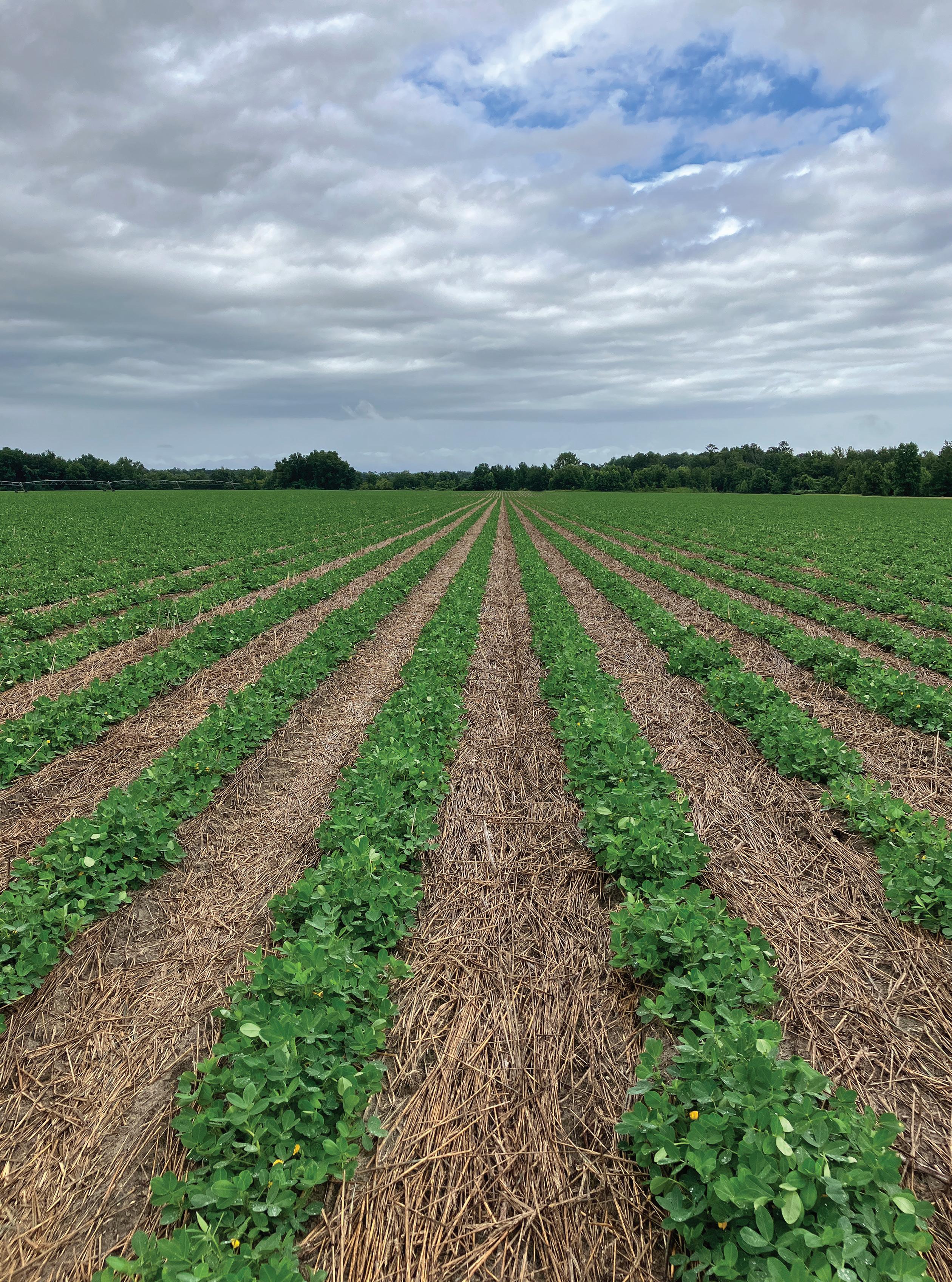

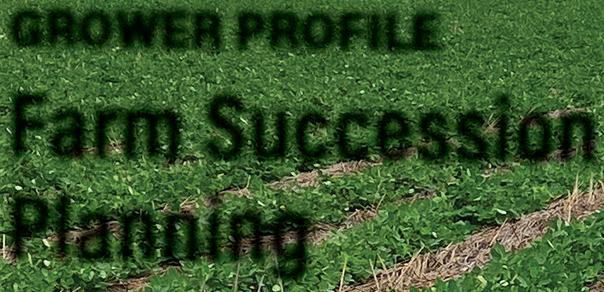


ONE GROWER PUBLISHING, LLC THE PEANUT PRODUCER'SMARKETING & PRODUCTION MAGAZINE www.peanutgrower.com PEANUT GROWER The MAY 2024 Use Past Problems, Multiple Tools To The New World of Pesticide Use GROWER PROFILE Farm Succession Planning Combat Disease




Rollin’ River on the Room reservations at The Westin can be made online at
. For detailed conference and registration information, visit www.southernpeanutfarmers.org or scan the QR code above. The Westin Savannah Harbor Golf Resort & Spa Savannah, Georgia • SOUTHERN PEANUT GROWERS CONFERENCE july 17-19, 2024
https://book.passkey.com/e/50678321










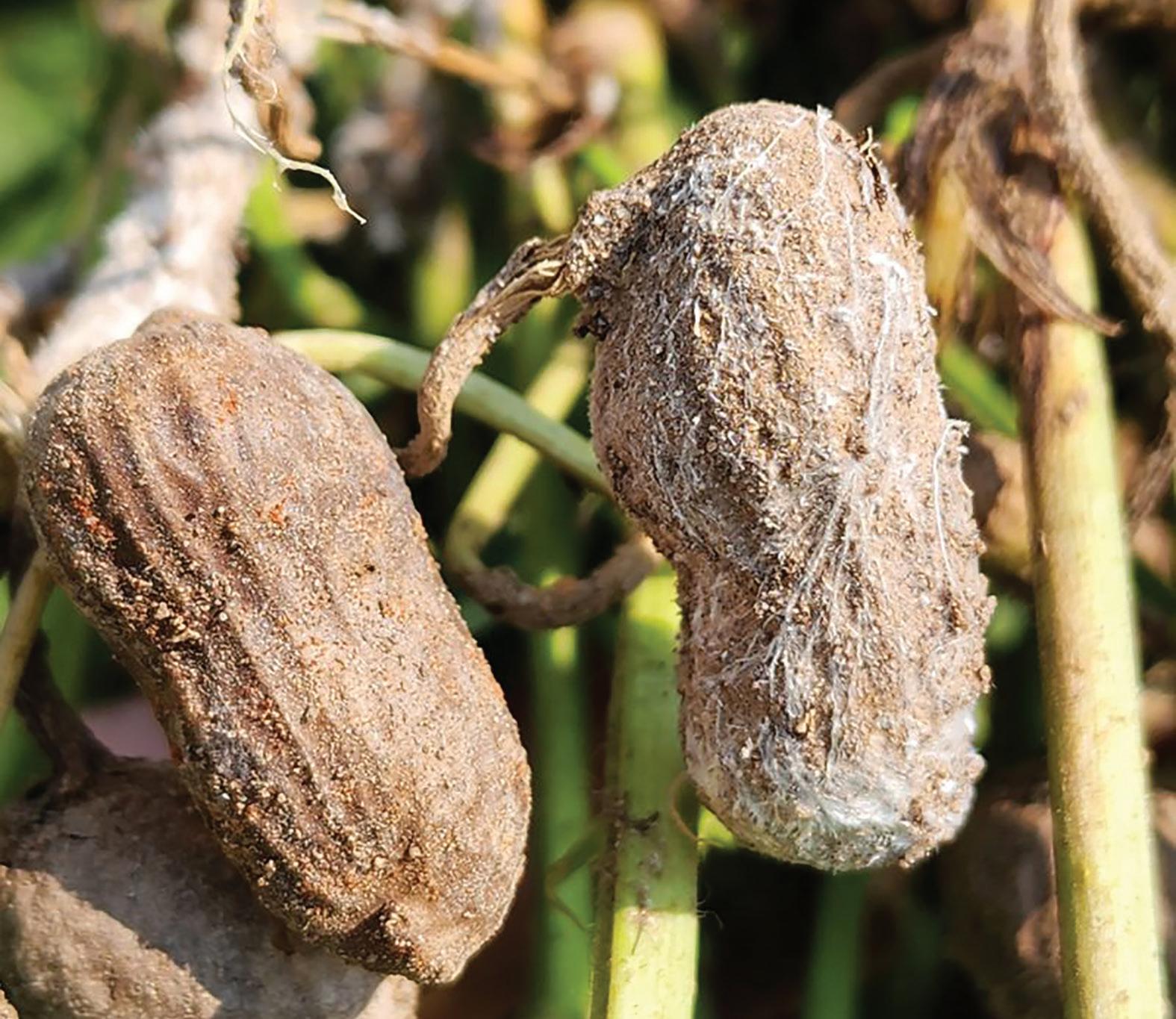




Despite no Farm Bill, the U.S. Congress is at work on agricultural legislation.

Use past problems and multiple management tools to combat pathogens in your fields.
The New World Of Pesticide Use
From chlorpyrifos to dicamba, growers can’t help being confused by recent court rulings.
Finding A Path Forward
Southwest Georgia peanut farmer Casey Cox Kerr discusses what drew her back to the farm and what she plans to leave for future generations.
MAY 2024 • THE PEANUT GROWER / 3 | @PEANUTGROWER 12 4 Editor’s Note Assemble your team to create a succession plan 5 News Briefs Delta Peanut selects CEO with tree nut experience 8 Market Watch
estimate brings on surprise, doubt Volume 36 • Number 5
Planting
ONE GROWER THE PEANUT PRODUCER'SMARKETING & PRODUCTION MAGAZINE www.peanutgrower.com PEANUT GROWER The MAY 2024 Use Past Problems, Multiple Tools To The New World of Pesticide Use GROWER PROFILE Farm Succession Planning Combat Disease Features 10
Cover photo by Amanda Huber
D.C. Matters
12 Disease
Notes
14
16
Departments 20 Peanut Pointers Gypsum availability again the topic of coffee-shop talk MAY 2024 Stay
Sign up for the monthly e-newsletter at peanutgrower.com to have exclusive industry news and content delivered directly to your inbox. www.peanutgrower.com PeanutGrower @PeanutGrower @ThePeanutGrower
Connected
EDITORIAL/PRODUCTION
Editor Amanda Huber ahuber@onegrower.com
Copy Editor Cassidy Nemec cnemec@onegrower.com
Art Director Ashley Kumpe
Digital Content Manager Katie Guthrie
ADMINISTRATION
Publisher/Vice President Lia Guthrie (901) 497-3689 lguthrie@onegrower.com
Associate Publisher/Editor-In-Chief Carroll Smith (901) 326-4443
Associate Publisher/Sales Scott Emerson (386) 462-1532 semerson@onegrower.com
Audience Services Kate Thomas (847) 559-7514
Production Manager David Boyd dboyd@onegrower.com
For subscription changes or change of address, call (847) 559-7578 or email peanutgrower@omeda.com
EDITORIAL ADVISORY BOARD
Scott Monfort
Extension Agronomist University of Georgia
Dell Cotton Peanut Growers Cooperative Marketing Assn., Franklin, VA
Kris Balkcom
Agri-Program Associate
Auburn University
Dan Anco
Extension Peanut Specialist
Clemson University
Emi Kimura
Extension Agronomist Texas A&M University
David Jordan
Extension Agronomist North Carolina State University
Glen Harris
Extension Agronomist University of Georgia
Jason Ferrell
Extension Weed Specialist University of Florida
ONE GROWER PUBLISHING, LLC
Mike Lamensdorf PRESIDENT/TREASURER Lia Guthrie PUBLISHER/VICE PRESIDENT
The Peanut Grower (ISSN 1042-9379) is an agribusiness magazine for U.S. peanut producers. Published in eight monthly issues, January through July and November. Annual subscriptions are $40.00. Single Copy price is $5.00. Annual overseas subscriptions are $70.00, including Canada/Mexico. Periodicals postage paid at at Memphis, Tennessee, and at additional mailing o ices. Copyright © 2024 One Grower Publishing, LLC, all rights reserved except where otherwise noted. The Peanut Grower ® is a registered trademark, which reserves all rights granted by the U.S. Patent and Trademark O ice in association with the registration. POSTMASTER: SEND ADDRESS CHANGES TO OMEDA COMMUNICATIONS, CUSTOMER SERVICE DEPARTMENT, P.O. BOX 1388, NORTHBROOK, IL 60065-1388. All statements, including product claims, are those of the person or organization making the statement or claim. The publisher does not adopt any such statement or claim as its own, and any such statement or claim does not necessarily reflect the opinion of the publisher. Printed in the USA.
One Grower Publishing, LLC, also publishes Cotton Farming, Rice Farming, Soybean South and Corn South
One Grower Publishing, LLC
875 W. Poplar Ave., Suite 23, Box 305 Collierville, TN 38017


Assemble Your Team Editor’s Note
Maybe it’s because I am getting older as are my parents or that I have now experience with a passing friend’s estate, but succession planning has been on my mind of late. It’s a complex process even with the simplest of situations. Planning for the future of your farm, land and legacy, while protecting heirs from burdensome taxes and regulations, is much more complicated.
You don’t farm alone. You have your spouse, children, partners, lenders, buying point, Extension, accountant, lawyer, suppliers and more. Because of the complexity in succession planning, it is not a do-it-yourself process either. One of the first steps is to pull together your team.

According to the American Farm Bureau Financial Services “Your Complete Guide To Succession Planning” found on the Learning Center website, “Succession planning is not just about the future of your farm or ranch; it’s a blueprint to preserve your agricultural legacy and protect the heirs who will inherit it…it’s essential to have a team of professionals who can advise you on best practices and put all of the paperwork in place to ensure a smooth transition.”
Who should be on your farm or ranch succession planning team? Many of those same people who are involved in your farming operations with a few additions.
The AFBF guide says an ideal succession-planning team includes the following nine people: current partners, heirs, accountant, lawyer, insurance agent, lender, financial planner, farm consultant and a Farm Service Agency payment limit eligibility advisor.
In “Finding A Path Forward” on page 16, Southwest Georgia peanut farmer Casey Cox Kerr talks about the gift her dad gave to her before her return to work on the farm and the gift she hopes to leave for her own daughter. Being able to do this calls for a good, thoughtful succession plan.
Planning ahead is a familiar part of farming, just make sure to also work on a farm succession plan.
4 / THE PEANUT GROWER • MAY 2024 PEANUTGROWER.COM
Amanda Huber Editor, e Peanut Grower


News Briefs
USDA Releases Prospective Plantings Report
The U.S. Department of Agriculture’s National Agricultural Statistics Service released the Prospective Plantings report in late March. The report provides estimates of U.S. farmers’ 2024 planting intentions based on surveys conducted during the first two weeks of March from a sample of nearly 72,000 farm operators across the nation.
According to the report, peanut growers intend to plant 1.65 million acres in 2024, down less than 1% from last year. Compared with 2023, planted acreage is expected to increase 6% or more in Florida, Georgia, Mississippi and South Carolina. The greatest decline is expected in Texas, where planted area is expected to be down 29% from last year. Beginning in 2024, peanut estimates began in Missouri but were discontinued in New Mexico.
All cotton-planted area for 2024 is estimated at 10.7 million acres, up 4% from last year. Upland area is estimated at 10.5 million acres, up 4%. American Pima area is estimated at 203,000 acres, up 38% from 2023.
Corn-planted area for all purposes in 2024 is estimated at 90.0 million acres, down 5% or 4.61 million acres from last year. Corn-planted acreage is expected to be down or unchanged in 38 of the 48 estimating states.
Soybean-planted area for 2024 is estimated at 86.5 million acres, up 3% from last year, with planted acreage up or unchanged in 24 of the 29 estimating States.
All wheat-planted area for 2024 is estimated at 47.5 million acres, down 4% from 2023.
Delta Peanut Selects CEO
Delta Peanut, the Jonesboro, Arkansas, peanut shelling facility, recently announced that Wes Battson has been named as its new chief executive officer. He assumed responsibilities beginning April 8, 2024. Board member and grow-
er owner, Jeremy Baltz, served as interim CEO.
“Following a comprehensive search, we are excited to have Wes lead Delta Peanut in its next phase of growth,” says David Wildly, Delta Peanut board chairman. “Wes has a deep understanding both of manufacturing and agriculture, and he is committed to creating value for our grower-owners.”
Battson brings 25+ years of experience with a record of success in leadership roles within global manufacturing companies, domestically and internationally. This combined experience will help Delta leverage its integrated supply chain and lead it into the next phase of growth.
“I am excited and honored to join the Delta Peanut team and contribute to enhancing grower returns. Delta Peanut’s commitment to its grower-owners, coupled with its bold vision for growth, innovation and quality, deeply resonates with me,” Battson says.
Battson’s experience includes the almond and walnut industries and most recently he served as CEO of Capay Farms. He holds a Bachelor of Science in biology and a minor in chemistry, plus a Master of Business Administration with a management information systems emphasis from California State University.

Research Foundation Plans
Assessing the wishes of the peanut industry regarding the future research priorities was the goal of the board of directors of the Peanut Research Foundation. Chairperson Courtney Dorsett of Premium Peanut says the Foundation will support marker development from the genome mapping plus support the breeding programs targeting quality and nutritional goals.
Dorsett listed the priorities as follows:
In Brief
• USDA estimates peanut plantings will be down less than 1%.
• New Delta Peanut CEO brings 25 years experience, leadership.
• Research Foundation outlines priorities for continued genome research.
• State organizations celebrate National Peanut Month.
• Weather outlook calls for dry fall, says UGA climatologist.
• Registration open for Peanut Congress, Southern Peanut Growers Conference.
1) release of TifCB7 variety with a high level of leaf spot resistance. 2) marker identification for resistance to white mold, sclerotinia, Tomato Spotted Wilt Virus, nematodes and rust; b) aflatoxin resistance; c) water efficiency, d) linoleic/oleic acid content, e) saturated and unsaturated fatty acid content, f) seed/ pod weight; g) flavor attributes.
Dorsett says the Foundation has only scratched the surface in the the development and utilization of the peanut genome and marker-assisted selection, which the Foundation helped fund. “We have protected valuable peanut germplasm and provided centralized storage for complex sets of data. The future looks good and support from the entire industry is needed.”
Sikes To Lead NPBPA
Greg Sikes of Candler Peanut Company buying point in Brooklet, Georgia, has been elected president of the National Peanut Buying Points Association. Cole McNair of BirdsongDamascus will serve as past president. Elected vice president is David Rushing of Birdsong Peanuts in Brooklet, Georgia.
MAY 2024 • THE PEANUT GROWER / 5 | @PEANUTGROWER


News Briefs
Rhonda Dixon of Dixon Farm Supply will continue as treasurer. Tyron Spearman of the Spearman Agency continues to serve as executive secretary, and Angela Elder will serve as assistant executive director.
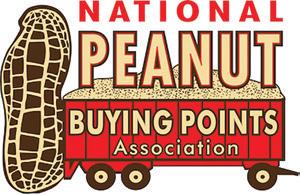
For more information or to join, visit www.peanutbuyingpoints.org . NPBPA is a member of the U.S. Peanut Federation and has a director on the Georgia Peanut Commission and the Federal State Inspection Service.
USA Peanut Congress Opens Registration
The 28th Annual USA Peanut Congress will be June 10-13, at the Ritz-Carlton, Amelia Island, Florida. The Congress is jointly hosted between American Peanut Council and American Peanut Shellers Association.
Members can take advantage of early bird registration rates until May 6. For further registration information or a schedule of events, go to www.peanut-shellers.org
Weather Outlook
Pam Knox, University of Georgia climatologist, outlines what producers can expect for this season’s weather.
“While we are currently quite wet across a lot of the region, the rapid switch to La Niña makes it more likely we will have a drought period this season,” Knox says. “Most of our recent droughts in the Southeast started in years when rapid transition occurred, including 1998, 2006, 2011 and 2016.”
Knox says the warmer-than-normal temperatures and drier-than-normal conditions will contribute to high demand for water by crops as well as increased evaporation from soil and water bodies, and that could cause drought to develop, especially if La Niña develops rapidly.
Where, when and if it occurs at all will depend on the activity in the tropics and where storms go, which isn’t known until they are formed.
“I would expect to see dry conditions

APPA Sponsors Peanut Day
The Alabama Peanut Producers Association celebrated March is National Peanut Month with a proclamation from Gov. Kay Ivey at the Alabama Capitol and a peanut day at the Alabama State House.
“Peanut day at the Alabama State House helps remind our legislators that peanuts are an important crop for Alabama agriculture,” says APPA president, Carl Sanders, “Adding about $200 million to the state’s economy.”
Throughout the morning, APPA board members handed out jars of locally sourced peanut butter and peanuts to legislators and talked with them about topics concerning our Alabama peanut farmers.
Gov. Ivey’s proclamation recognized the peanut as the state legume of Alabama, as well as the impact the peanut industry has on the economy of the state, the farmers who grow peanuts, the nutritional value and environmentally friendly attributes. Gov. Ivey also received cans of peanuts from Sanders.
in the fall across the region except where a tropical storm system moves near or over the area,” Knox says.
Georgia Farmers Invest In Research
The Georgia Peanut Commission board of directors approved $791,639 in funding for the 2024-25 research budget year. The research projects approved include 40 project proposals submitted from the University of Georgia, Abraham Baldwin Agricultural College and the USDA Agricultural Research Service.
“As a peanut grower, I’m proud to invest in the Georgia Peanut Commission and in the future of the peanut industry by supporting research that continues to demonstrate a return on our investment,” says Donald Chase, research committee chairman.
The research programs primarily focus on peanut breeding, conservation meth-
ods, irrigation and water management, as well as pests, weed and disease management. Additional projects focus on non-food uses of peanuts to provide new opportunities for growth in the industry. These projects look at utilizing high-oleic peanuts in poultry feed, converting peanut oil from a non-drying oil to a drying oil for timber oils and coatings, reviewing George Washington Carver’s peanut uses for application in today’s world and finding new, non-food applications of peanuts and by-products.
Additionally, GPC manages funding for the Southeastern Peanut Research Initiative that includes research funding of $1.5 million for projects in Alabama, Florida and Georgia. These projects are funded through the National Peanut Board checkoff dollars from farmers.
For additional information and a complete list of the research projects funded by the Georgia Peanut Commission, visit www.gapeanuts.com
6 / THE PEANUT GROWER • MAY 2024 PEANUTGROWER.COM


News Briefs
GPC Celebrates National Peanut Month
The Georgia peanut industry kicked off March is National Peanut Month by hosting the 2024 Georgia PB&J Day in Atlanta, Georgia. During the event, the Georgia Peanut Commission and Peanut Proud donated 10,080 jars of peanut butter to the Atlanta Community Food Bank.
Governor Brian Kemp presented a proclamation recognizing March as National Peanut Month while Sen. Russ Goodman, chairman of the Senate Agriculture and Consumer Affairs Committee, and Rep. Robert Dickey, chairman of the House Agriculture and Consumer Affairs Committee presented resolutions recognizing the importance of Georgia’s peanut industry.
Joe Boddiford, GPC chairman, says, “Georgia’s 3,700 peanut farmers contribute approximately $2 billion annually to the state and local economy.”



Sponsors and exhibitors included the Georgia Peanut Commission, National Peanut Buying Points Association, Kroger, Georgia Farm Bureau, Georgia FederalState Inspection Service, National Peanut Board, Peanut Proud, Atlanta Community Food Bank, Premium Peanut and the University of Georgia Peanut Team.
As part of the celebration, peanut butter valued at $10,000, was presented to the Atlanta Community Food Bank, which provides food and grocery products to nearly 700 community-based, nonprofit partner agencies with hunger relief programs throughout 29 counties in metro Atlanta and north Georgia.
Ben Burgess, corporate relations manager, says, “A recent study showed an average of 200,000 food-insecure households are served each month through the Atlanta Community Food Bank network. Peanut butter is a very nutritious and important product to those clients because it has a stable shelf life.”
2024 Peanut Growers Conference

The 25th Annual Southern Peanut Growers Conference will be held July 17-19, 2024, at the Westin Savannah Harbor Golf Resort & Spa, Savannah, Georgia. The three-day event provides farmers with information about peanut production, legislative issues, marketing and promotions. Visit the conference blog at southernpeanutfarmers.org/ southern-peanut-growers-conference/ to see speaker and sponsor interviews as well as photos from past conferences.
In addition to the conference sessions, the event focuses on the family by offering a spouse program and a golf tournament. Additional information about the conference and sponsorship opportunities are available by contacting one of the coordinating partners.
















MAY 2024 • THE PEANUT GROWER / 7 | @PEANUTGROWER
SPRAY TECHNOLOGY AND PRECISION FARMING SOLUTIONS NO BETTER WAY TO SPRAY Visit www.teejet.com/spray to learn more or visit your local TeeJet dealer Precision Spray Tips System Control Valves Field Computers and GPS Guidance Spray Boom Components


Market Watch
Planting Estimate Brings On Surprise, Doubt
Farmers usually get excited about this time of the year. The smell of the fresh-turned dirt brings back the good old days when the forefathers felt that production of food, fiber, fuel and shelter were all positive goals that united the family and preserved America’s future.
Gradually, things have changed. Excitement and optimism are dimmed by various problems, and farming becomes about survival. Production costs, inflation, international issues including the war in Ukraine, tariffs on our products increasing the price, cost of fertilizer, water wars, lack of border security, weeds becoming herbicide resistant, an increasingly complex global regulatory environment and climate change…all combine to dampen optimism.
Prices for gas and diesel have risen of late but are expected to decline about 2% in 2024. Any competing crops continue to have low prices and are at or below cost of production. Decisions on what to plant can only wait so long.
Peanut producers have listed some major concerns for the 2024 crop including early contract prices, cotton and corn prices stalled at or below cost of production, a serious drought in the Southwest growing area and unexpected weather in the Southeast. Wet, cool conditions through mid-April will push planting further into the spring. Planting too late can spell trouble with Tomato Spotted Wilt Virus. Producers also struggle to keep up with the U.S. Environmental Protection Agency’s regulations and the court’s revoking of rules, as in chlorpyrifos tolerances and Dicamba use in cotton. Production costs, pest and disease problems, nematodes, hurricanes and harvest weather – the list of real concerns goes on and on.
Planted Acres
The U.S. Department of Agriculture’s National Agricultural Statistics Service projects 1.65 million acres will be planted to peanuts in 2024, a less than 1% increase from 2023. That was somewhat of a surprise as other estimates have ranged from a 5% to 7% increase. Georgia, the largest-producing state, is projected to plant 820,000 acres, an increase of 5.8% from last year.
Southeast acreage is projected to be 1.24 million acres, up 7.2% from last year. In the Southwest, peanuts are projected to be planted on 175,000 acres, down 30% from 2023. However, some West Texas growers have indicated they are likely to plant about the same amount as last season and did not agree with the estimated 30% reduction. The outcome in this area will depend on further drought or recovery.
In the Virginia-Carolina area, peanuts are projected to be planted on 229,000 acres, virtually unchanged from 2023.
Farmer-Stock Pricing
In the Southeast, buying points report
 J. Tyron Spearman Contributing Editor, e Peanut Grower
J. Tyron Spearman Contributing Editor, e Peanut Grower
that shellers are offering a contract for runner-type peanuts for 2024 at $550 per ton for high-oleic peanuts and $535 per ton for non-high oleics. Tonnage is limited for each buying point. There are some perks such as $25 per ton for irrigation. Some shellers are not buying high-oleic varieties but are matching the price for regular oleics. Some buying points report good response, while others say farmers are still watching cotton and corn prices.
In the V-C region, buying points report contracts were being offered at $525 per ton for runner-type peanuts, $550 per ton for high oleics and $545 per ton for Virginia type. In the Southwest, runner-type contracts are $625 per ton and Virginias are at $675 per ton, all on limited acres with water. A rain is needed before farmers can plant.
The near market remains very firm, difficult to get offers and prices in the high $.60s and low $.70s, depending on grade and specifications. New-crop buyers are convinced there will be more peanuts planted in ’24 so they are looking for offers in the mid $0.50s to make
8 / THE PEANUT GROWER • MAY 2024 PEANUTGROWER.COM
Leading Marketing Indicators (April 1, 2024) 2023 Planted Acreage (+14%) ....................................... 1,645,000 acres 2023 Production ................................................................. 2,945,010 tons 2024 Est. Planted Acreage (+.4%) ................................. 1,651,000 acres 2023 Market Loan 2023-2024 ............................................ 2,340,259 tons 2023-24 In Loan (4-2-24) .................................................... 1,461,054 tons 2023-24 Domestic Usage (6 Mo.) ................................................. -1.56 % 2023 Exports (Jan. – Dec.) ............................................................ +18.0% NATIONAL POSTED PRICE (per ton) Runners - $425.29, Spanish - $413.12, Valencia and Virginias - $431.71


Market Watch
a trade on the 2024 crop.
Buyers are hopeful new-crop pricing has room to move downward with an acreage increase, but that has not happened. With Argentina’s 2023 crop having major issues and the U.S. crop having less-than-optimal yields and maturity, the result was a big increase in U.S. exports of the remaining 2022 crop that was an excellent quality. Argentina appears to have a great crop coming in this season and will likely return to being the preferred origin for European Union imports. Brazil could have issues with their crop, particularly from aflatoxin.
This has left us with a projected carry-out below one million metric tons headed into the crop harvest this fall. Despite all the EU buying interest, the market was fairly slow to react in part due to the planted acreage report and a prolonged period with few domestic trades. Pricing rose into the mid $.60s per pound and has settled now where it currently sits.
Domestic Markets
USDA is reporting raw-shelled peanut usage down 1.56% for the six-month period in primary products with peanut butter showing an increase during the period of 1%. Peanut candy took a major fall in January; however, usage was down only 1.2% for the six months. Snacks were down 11% for the year. USDA’s
‘‘ The industry needs and wants a good quality, plentiful crop. You deserve a profit, and buyers are willing to pay to keep you in business. Even with the many concerns, 2024 should be a good year for peanuts.
summary showed usage of shelled edible peanuts down 2%.
In a major victory for peanuts, the U.S. Food and Drug Administration approved Xolair (omalizumab) to be used for reducing allergic reactions to multiple foods after accidental exposure.
Export Usage
On exports, 85% of U.S. peanuts currently go to mature markets. Market shares show China with 14%, Mexico with 29%, Europe (excluding the United Kingdom) is 20%, Canada with 25% and Japan with 3%. The next step change in U.S. exports will need to come from new categories in existing geographies or new geographic markets. The United States is not seen as a consistent supplier to Europe, which is conditioned for Argentina flavor/texture. Future U.S. import share to Europe is limited.
Competitiveness outweighs most marketing factors in a majority of export destinations. In an increasingly complex global regulatory environment, the U.S. peanut industry needs to be
Peanut Team To Visit South Korea
The American Peanut Council is heading to South Korea as part of the U.S. Department of Agriculture’s agribusiness trade mission. APC applied for and was accepted to join the mission to Seoul in March led by USDA’s Foreign Agricultural Affairs under secretary Alexis Taylor. South Korea is the eleventh-largest market for U.S. peanut exports, with total shipments reaching 4,521 metric tons in 2023, valued at a record-high $15.9 million.
Korea’s retail market for nuts, seeds and trail mixes was estimated at $298.8 million in 2023, while the market for nut and seed-based spreads was estimated at $9.1 million in 2023. In Korea, peanuts are commonly prepared as a snack after roasting, blanching or adding seasonings. Korean adults have
fully engaged in dealing with trade and technical threats, including aflatoxin, CODEX, a set of internationally adopted food standards, and much more. The American Peanut Council’s new market development process targets one new market per year.
Farm Bill Limbo
The Farm Bill and, therefore, the peanut program, remains unsettled. Farmers continue to plead for an increase in the reference price. If increased, it would be 2026 before farmers receive a price loss coverage payment. The search for funding continues, with suggestions ranging from using Commodity Credit Corporation funds, to unused climate change or COVID-19 funds.
Check with your buying point and sheller as there is time to change your 2024 plans. The industry needs and wants a good quality, plentiful crop. You deserve a profit, and buyers are willing to pay to keep you in business. Even with the many concerns, 2024 should be a good year for peanuts.
favored peanuts with alcoholic beverages, while children enjoy various products, such as peanut confections and snacks. A range of peanut products with a variety of seasoning options, such as honey and coffee-covered peanuts, have been launched in the market, further leading to peanuts’ popularity.
“APC is excited to join USDA on the Korean trade mission,” says APC senior director of international programs Peter Vlazakis, who will be leading the U.S. peanut delegation. “We view it as a tremendous opportunity to meet with potential importers and processors, learn more about the country’s market dynamics and engage with the other U.S. agribusinesses on the mission, all while promoting U.S. peanuts and looking for opportunities to increase exports.”
MAY 2024 • THE PEANUT GROWER / 9 | @PEANUTGROWER
D.C. Matters
Despite no Farm Bill, the U.S. Congress is at work on agricultural legislation.
The U.S. Congress recently passed legislation that included six appropriations packages: Agriculture, Rural Development, Food and Drug Administration and Related Agencies; Commerce, Justice, Science and Related Agencies; Energy and Water Development and Related Agencies; Interior, Environment and Related Agencies; Transportation, Housing and Urban Development; and Military Construction, Veterans Affairs and Related Agencies. President Biden signed this legislation into law March 9.
Congress Passes Agriculture Appropriations Legislation
The Agriculture, Rural Development, Food and Drug Administration and Related Agencies appropriations legislation funds the U.S. Department of Agriculture for fiscal year 2024. Included in the bill are peanut provisions proposed by agriculture subcommittee ranking member Sanford Bishop (GA-02) and supported by the peanut industry. These U.S. Peanut Federation-supported research initiatives for nutrition and aflatoxin are in their third and fourth years of funding, respectably.
Total funding for fiscal year 2023 was $4 million for aflatoxin research at the USDA’s Peanut Research Laboratory in Dawson, Georgia, plus research at Fort Valley State University and other land grant universities and $1.5 million for the USDA Agricultural Research Service to work on peanut nutrition priorities. The ARS has been working with The Peanut Institute on nutrition projects.
Peanut Research Initiative Funding
For fiscal year 2024, total funding is $2 million for peanut nutrition research and $4 million for aflatoxin research. Legislative report language is as follows:
Peanut Nutrition Research – The committee recognizes the need for more research to identify how peanut consumption contributes to overall health and wellness and reduces chronic disease risk in various groups and across the lifespan. The committee provides an increase of $500,000 to support peanut nutrition research. Research topics should include chronic diseases, nutrition and wellness across the lifespan, health disparities, dietary patterns for optimal health and nutrition for the future.
Peanut Research – The committee provides no less than the fiscal year 2023 level to support research activities to mitigate aflatoxin contamination in peanuts. The committee directs ARS to enhance ongoing collaborations with land-grant institutions to further advance research efforts.

Representatives from the U.S. Peanut Federation traveled to Washington, D.C. in March for the annual Spring Fly-In to talk with leaders about peanut industry priorities.
The second tranche of appropriations legislation was approved March 22, fully funding the federal government for fiscal year 2024.
U.S. Peanut Federation Holds Spring Fly-In
Representatives from the U.S. Peanut Federation traveled to Washington, D.C. in March for their annual Spring Fly-In. During the trip, USPF representatives met with key members of the U.S. House of Representatives and U.S. Senate, as well as senior agricultural staff to discuss issues facing the peanut industry today. The USPF Fly-In is an essential event to connect with Congress about peanut industry priorities, especially since Farm Bill programs are up for reauthorization in 2024.
During their meetings, USPF representatives discussed the rising costs of production for peanuts, the Price Loss Coverage program and priorities for the Farm Bill. Rising input costs, supply chain disruptions, labor shortages and low prices have all contributed to the difficult conditions peanut farmers are facing today. Without an effective safety net, growers will continue to struggle, and that is the message that USPF representatives voiced on Capitol Hill.
In late 2023, the U.S. Congress passed a one-year extension of Farm Bill programs at the same levels authorized in the 2018 Farm Bill. USPF representatives heard from members of Congress and staff that while the Farm Bill has been extended, work is ongoing. However, there is still uncertainty as to whether a Farm Bill will be considered this year. PG
10 / THE PEANUT GROWER • MAY 2024 PEANUTGROWER.COM


Scan the QR code with your phone to renew today for FREE!


TIME IS PRECIOUS.


We know you’re busy with more important things, so we’ll get to the point. The U.S. Postal Service requires that we receive a written request from you to continue sending The Peanut Grower for FREE.
Please take a few moments to renew online by scanning the QR code. We don’t want to lose you as a reader.




PEANUTGROWER.COM PEANUTGROWER @PEANUTGROWER @THEPEANUTGROWER
Disease Notes
Use past problems and multiple management tools to combat pathogens in your fields.
By Nicholas Dufault, University of Florida Associate Professor of Plant Pathology
Areview of past disease problems that affected the peanut crop offers a good look at management considerations for this season. Three prevalent diseases, southern stem rot/white mold, peanut leaf spot and rust, cause much of the damage to peanuts in our state.
Southern Stem Rot/White Mold
Southern stem rot, also called white mold in the lower Southeastern peanut production areas, is a disease that received a lot of attention in 2023. The environment of hot and wet followed by periods of hot and dry led to peanut yield losses in Florida, especially in dryland production. In some situations where varieties with resistance to the pathogen were planted and high-quality fungicide programs were used, significant damage from this disease was still present.
What can be done in 2024 to better manage this disease? First, consider adding an extra year or two to your crop rotation in fields that had significant yield losses despite using a resistant variety with a stem rot-focused fungicide program. If land availability for an adequate rotation is limited, consider adding an early stem rot-focused fungicide spray to your program and finding a way to apply the fungicide product to the crown, such as spraying at night or using a higher gallons-per acre water volume at 75 days after planting.
Remember, fungicides are great disease management tools, but they have limitations when it comes to disease control.
Leaf Spots
There are two types of leaf spot diseases that affect peanuts: early leaf spot and late leaf spot. This is important because our peanut varieties and fungicides can respond differently to these two diseases, and it is especially important when using fungicides with Fungicide Resistance Action Committee Group 11 (QoI) fungicide products. Resistance to this fungicide class has been detected in pathogens that cause both diseases; however, complete resistance to QoI fungicides has only been detected in the early leaf spot pathogen. Thus, it is still possible to see adequate disease management of late leaf spot with this fungicide class.
It is often difficult to tell the difference between these diseases and abiotic problems in the field, but accurate diagnosis is possible with a microscope and/or hand lens. To avoid fungicide management problems with fungicides, it is recommended
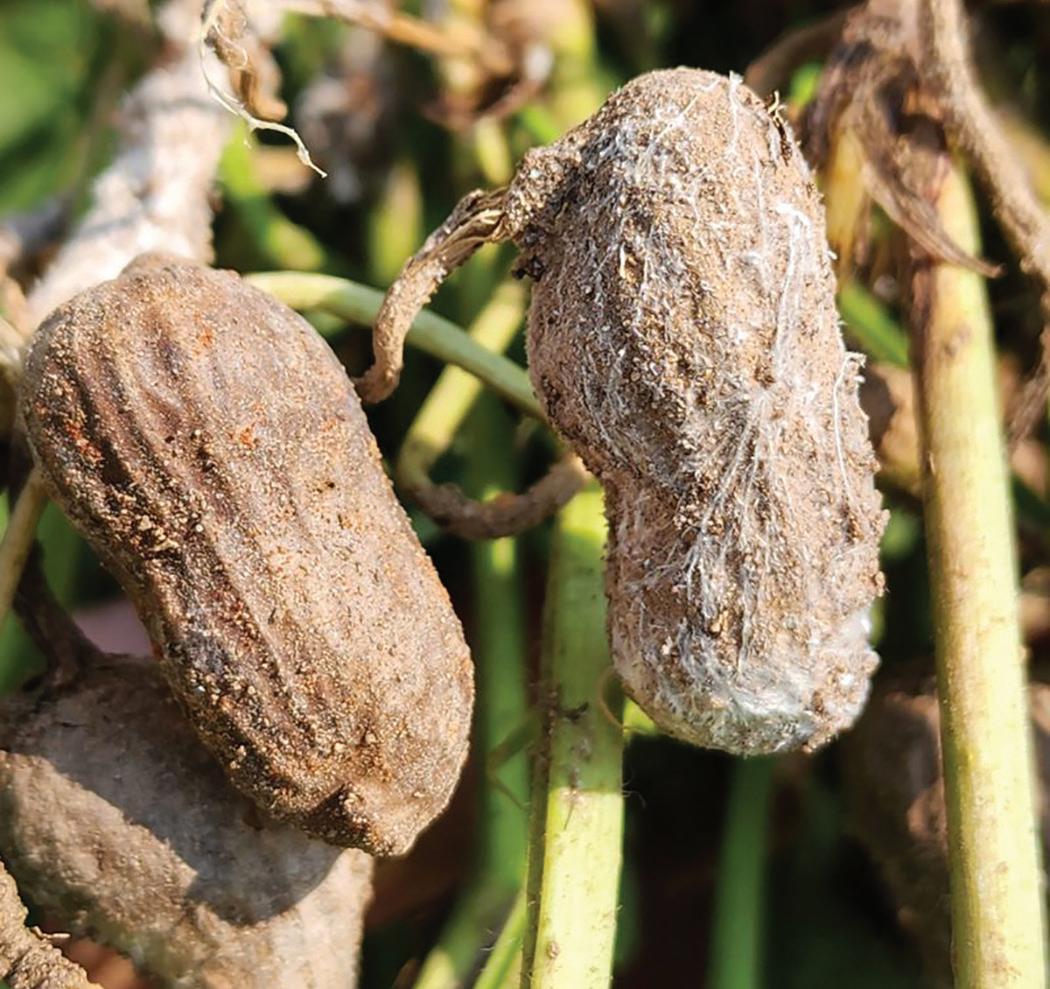

12 / THE PEANUT GROWER • MAY 2024 PEANUTGROWER.COM
NICK DUFAULT, UF/IFAS
Stem rot pathogen mycelium on peanut pods.
NICK DUFAULT, UF/IFAS
Late leaf spot lesions and stroma on the underside of a peanut leaflet.


that a leaf spot-resistant variety is planted, as it can reduce the impact of a fungicide failure.
Rust
Peanut rust showed up late in the 2023 season but quickly spread in fields where it was present. Late-season infections do not always lead to yield losses in crops harvested within a timely manner; however, a five-to-seven-day delay in harvest can cause significant damage to a peanut crop. A late-season tropical storm would delay timely fungicide applications that can slow this disease down.
Should rust become an issue in 2024, most leaf spot products work well for managing this disease, but adding in FRAC group 11 modes of action fungicides can improve management of this disease.
Three additional diseases of interest to consider when developing your management program in peanuts are cylindrocladium black rot, Tomato Spotted Wilt Virus and Aspergillus Crown Rot.
Use Multiple Management Tools
It is important to identify the diseases you have each year, as this will help you prevent disease problems from carrying over into the next season. Diseases can be a substantial problem when the right environment is present even if we use resistant varieties and a good fungicide program. In areas where those two techniques fail, it is critical to consider adding a third management tool, such as crop rotation or delayed planting.
Additional Tips From Bob Kemerait, University of Georgia Extension Plant Pathologist
Peanut leaf spot diseases, especially late leaf spot, were problematic in 2023 but not as severe as in 2021. Leaf spot diseases remain a critical threat to profitability. Factors that increase the threat to leaf spot include environmental conditions, such as multiple rain events that are favorable for the development and spread of disease and also a ect a grower’s ability to make timely fungicide applications, and short crop rotations. Combinations of these factors put tremendous pressure on some fungicide programs.
Management Tip: To prevent losses to leaf spot, especially late leaf spot, it is imperative to: a) stay on a timely, proven program; b) select fungicides or mixtures of fungicides based upon threat of disease in the field; c) continue appropriate management programs through the end of the season.
Because of the increased threat from late leaf spot in recent years, some fungicide programs may have changed. Carefully consider the choice of product and timing for application throughout the season to minimize losses to disease.
White mold was generally more severe in 2023 than in 2022, possibly because of the hotter conditions. Also, with peanuts “staying in the ground” for nearly 160 days, more attention must be given to protecting the crop from white mold even after the traditional “four-block, 60-to-104-days-after-planting” window ends. PG
For more information on peanut disease management, please visit the UF/IFAS Florida Peanut Team website or contact your local county agent. PG
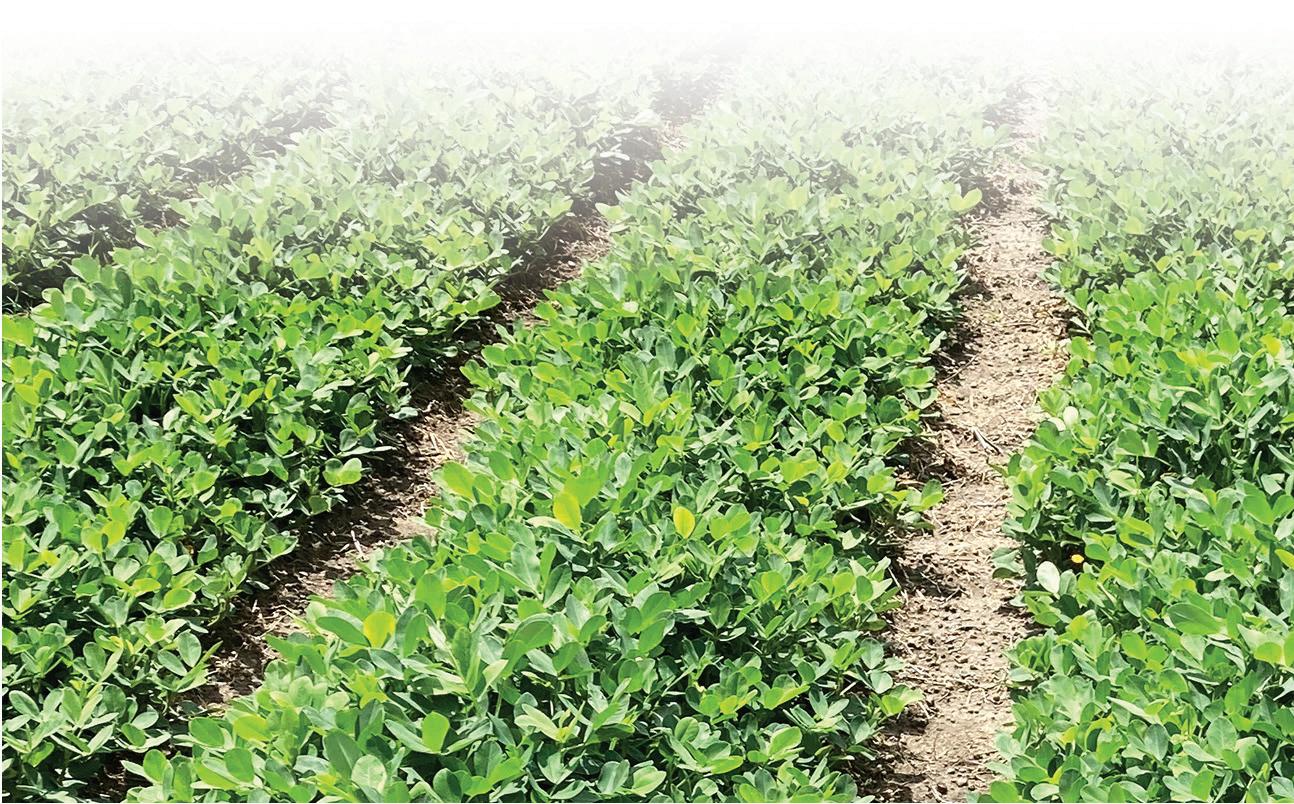

 An example of peanut rust pustules.
Spray burn lesions on peanut leaves.
NICK DUFAULT, UF/IFAS
NICK DUFAULT, UF/IFAS
An example of peanut rust pustules.
Spray burn lesions on peanut leaves.
NICK DUFAULT, UF/IFAS
NICK DUFAULT, UF/IFAS
The New World Of Pesticide Use
From chlorpyrifos to dicamba,
growers can’t help being confused by recent rulings.
By Amanda Huber
That courts now complicate pesticide registration and application is something growers should get used to, say University of Georgia Extension specialists. Both peanuts and cotton are dealing with chemicals being revoked, then back, then re-revoked, making the situation “clear as mud,” as the saying goes. UGA Extension peanut entomologist Mark Abney has spent the winter and early spring meetings figuring out where the legal boundaries are on chlorpyrifos and explaining it to producers.
“When the U.S. Environmental Protection Agency made their decision on chlorpyrifos, they didn’t cancel the label. Instead, they revoked the tolerance for residue,” he says. “Tolerance is the amount of product residue that can be on the crop legally when it is sold. You have a certain tolerance in parts per billion of active ingredient. If you’re under that level, you’re fine. If you’re over that level, you’ve exceeded the tolerance of that crop and it is considered ‘adulterated,’ the EPA’s word, and the product can’t be sold.
“Every chemical, additive, pesticide, etc., has a residue tolerance. The tests that establish these tolerance levels happen during the registration process by the company with the EPA checking to make sure the way we use products does not leave an amount of residue that is harmful to our health.”
When the EPA revoked the tolerances on chlorpyrifos, Abney says there was still a legal label, but with zero tolerance, the product could not be used in peanuts or any other crop.
The Latest Ruling
Revoking of tolerances occurred because of a court case and a ruling that was made in the 9th circuit court in San Francisco, who told the EPA to either revoke all tolerances or review all chlorpyrifos use patterns to see if any use patterns could be deemed “safe.”
Abney says the EPA chose to revoke all tolerances, but the fact that they had options becomes important in the next ruling.
In another lawsuit that had made its way to the 8th circuit court in New Orleans, a judge in this ruling said that the EPA did not give any consideration to the other option and instead chose the easy, quick route of revoking tolerances.
Abney says, “In the judge’s ruling, he said, essentially, ‘Just because something is hard doesn’t mean you shouldn’t do it.’ The judge said the EPA’s choice to revoke tolerances was ‘arbitrary’ and ‘capricious,’ and he threw it out.”
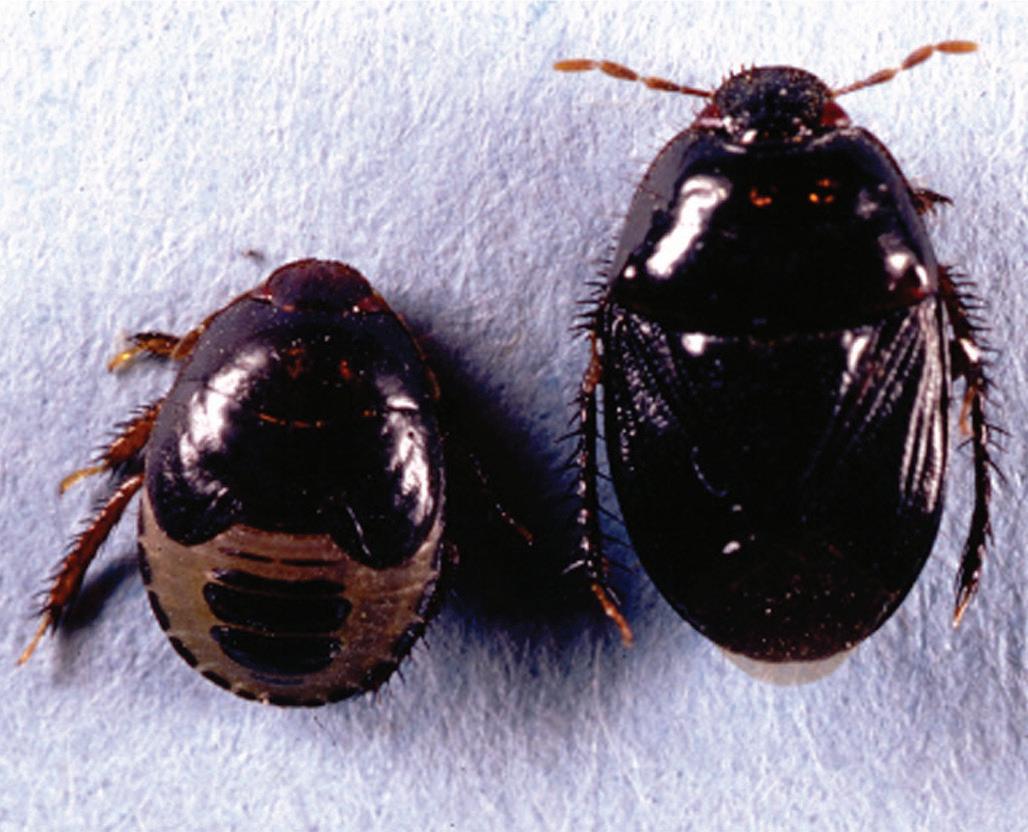
Granular chlorpyrifos is one of the only insecticides for the southern corn rootworm complex, including the banded cucumber beetle (opposite page), and burrower bug. Although the insecticide can be used in 2024, the U.S. EPA plans to revoke all tolerances again at the end of the year.
That means as of his ruling in late December 2023, all fooduse tolerances that were in place when revoked were restored. However, the EPA eventually said they would move to re-revoke all tolerances at the end of 2024.
Check Your Contract For Pesticide Use Restrictions
Unfortunately, Abney says that not everyone who may need chlorpyrifos will probably be able to get it this one last season.
“What’s in warehouses now and left over from a few years ago is what we’ve got to use this season,” Abney says. “My guess is that everyone who would need and want to use chlorpyrifos will not be able to get it.”
Abney says some companies voluntarily surrendered their product labels, which would make use of those products illegal. Also, chlorpyrifos liquid cannot be used on peanuts that have emerged, only granular chlorpyrifos.
Additionally, because peanuts are exported and other countries often have different acceptable tolerance levels, some buyers will stipulate pesticides that cannot be used.
“Although we may say you can use a certain product, you need to check your contract,” Abney says. “Your contract with
14 / THE PEANUT GROWER • MAY 2024 PEANUTGROWER.COM
your buyer may include products that you cannot use in your crop.”
“This is what happened with propiconazole,” says UGA Extension peanut specialist Scott Monfort. “Buyers said they would not buy peanuts where growers had used propiconazole because it could not be sold on the export market. This essentially meant growers could not use it.”
Abney says, “We don’t see your contract with your buyer. I can only tell you what the federal government says is legal to use. If you are a peanut grower and you get your hands on granular chlorpyrifos, it is legal to use it in 2024. Check your contract and make sure you don’t have a clause that says you can’t use it.
“If you don’t really need it,” he says, “then don’t buy it. Leave it for those folks who need it for insect management.”
Going Forward
In the future, it is likely producers can only expect more of this type of back and forth through the courts, causing confusion and frustration. But growers are not the only ones.
“For those of us who work in areas that involve the use of pesticides, this is the world we live in now,” says UGA weed scientist Eric Prostko. “Courts are involved in registration processes and environmental or activist nongovernmental organizations, or NGOs, have figured out they can sue the EPA to get what they want, which is no pesticide use whatsoever. That’s what is happening now.”
Brigit Rollins, staff attorney at the National Agricultural Law Center, says recent litigation has spurred significant changes in pesticide regulation, including vacating the registration for widely used pesticides and shifts in EPA enforcement philosophy.
“Over the past few years, we’ve seen dicamba become unavailable for use more than once as the direct result of lawsuits and subsequent court decisions,” she says. “Going forward, we’re expecting to see additional restrictions on pesticide use as the EPA works to come into better compliance with the Endangered Species Act.”
Rollins, along with Rod Snyder, senior advisor for agriculture to the U.S. EPA administrator, will be featured speakers at the 11th Annual Mid-South Agricultural & Environmental Law Conference June 6-7, 2024, in Memphis, Tennessee, during the session entitled, “Tomorrow’s Harvest: An Overview of the Regulatory and Litigation Landscape for Crop Protection Products.” Read more about this conference in the April issue of Cotton Farming magazine.
Rollins says the EPA’s shift toward a closer alignment with the Endangered Species Act will mean increased restrictions for applicators. “With changes to pesticide labels coming in rapidly, and sometimes unexpectedly for producers, staying informed is critical.”
Unfortunately, it isn’t easy to keep up with these changes. PG

| @PEANUTGROWER

Finding A Path Forward
Southwest Georgia peanut farmer Casey Cox Kerr discusses what drew her back to the farm and what she plans to leave for future generations.
When Casey Cox Kerr was a child, she watched her dad farm while snacking on raw peanuts atop a peanut wagon.
The 32-year-old comes from six generations of farmers. Their 2,400-acre farm is filled with longleaf pine, soybeans, peanuts, sweet corn and field corn. It sits right along the Flint River in Camilla, Georgia, some 31 miles south of Albany.
Kerr never expected to take on the farm, named Longleaf Ridge, but now she’s leading its operations. She inherited the family farm – a practice at risk in today’s agricultural climate.
Census data from the U.S. Department of Agriculture, released Feb. 13, showed an alarming loss in family farms. There were 141,733 fewer farms in 2022 than in 2017, according to the 2022 Census of Agriculture. While the number of beginning farmers increased, census numbers show there are more farmers over the age of 65 than younger farmers. Almost 1.3 million farmers are at or beyond retirement age, meaning many will start thinking about succession plans.
However, farming families are dealing with a younger generation of children going off to college and finding jobs in cities as they face a dying rural economy, rising operational costs and volatile weather and climate patterns. The work is not easy, and many young people question the vitality of taking over the family farm.
The Gift Of Choice
Kerr spent her childhood on the Flint River that runs alongside her family’s land and in the longleaf pine forests that make up more than half of Longleaf Ridge Farm. She says she developed a strong love for the land.
Kerr is her parents’ only child, but she says there was never an expectation for her to come back to the farm.
“The greatest gift my parents gave me was the gift of choice,” Kerr says. “They never pressured me – not once. They would always position it like ‘This is here if you ever want it, but we want you to be happy so go do what makes you happy.’”
In 2009, Kerr moved to Gainesville, Florida, to study
16 / THE PEANUT GROWER • MAY 2024 PEANUTGROWER.COM
NATIONAL PEANUT BOARD
Natural Resource Conservation at the University of Florida. She studied topics that would later intersect with taking over the family business: entrepreneurship, agribusiness accounting, agri-economics, soil culture and natural resource policy.
After college, she moved home and took a job with the Flint River Soil and Conservation District. She worked there for six years and served as executive director for five. Kerr says she developed an understanding of the correlation between agriculture and natural resources.
Kerr and her family were heavily involved in the ongoing tri-state water wars between Georgia, Florida and Alabama over water usage from the Apalachicola-Chattahoochee-Flint River Basin. She was just graduating college when Florida’s former governor, Rick Scott, sued Georgia over its water usage in 2013.
When Hurricane Michael hit in 2018, bringing devastation to farms across southwest Georgia, Kerr says she made the decision to transition to working on her family’s farm full-time. She says she realized one storm could change everything. The farm needed to diversify if it was going to face extreme weather.
“We’re in a business where everything we do is dependent upon nature, and that is really scary.” Kerr says. “It’s really challenging, but it also really motivated me personally to look at ways to innovate what we’re doing and figure out a new path forward.”
Weather and climate volatility are just two of the challenges, Kerr says, that may drive young farmers away from taking over their family farm. She says rising market prices, dependence on supply and demand and trade deals they have no control over also create a level of uncertainty that doesn’t exist in other jobs.
“There’s so much risk involved,” Kerr says. “I can understand why people are hesitant to come back. It can be so much easier to just go and get a steady job.”

Old farmers are also hesitant to step back from the operations, she says.
“For a lot of farmers it’s not just a job, it’s a way of life,” she says. “It’s a purpose. I think that’s where some families really struggle in succession and transition because it’s really hard to let go.”
Challenges For Farmers, Planning For Succession
Curt Covington, the senior director of institution credit at AgAmerica, says the rural economy is driving young people,
“Families looking to pass on their farms to younger relatives need to start preparing now, developing relationships with strategic partners like lawyers and accountants…start setting up a succession plan — who will take over operations — and an estate plan — the division of assets. This starts with an important question for heirs: Do you want to be here, and if you do, how do you see your role?”
CURT COVINGTON AgAmerica senior director of institution credit
many with higher education, away from the farm and into cities. Many rural communities are losing their hospitals, schools and primary businesses.
Covington says this is an issue because it leads to consolidation in farmland space and valuable agricultural land being sold to investors with interests outside the community. “The fabric of rural America is harmed when families don’t have continuity in their family farming operation,” he says. “All you have to do is take a look at the landscape of private equity that is really taking on the farm asset sector. Many of those private equities don’t live in those communities.”

Covington says much of rural America still doesn’t have broadband or access to the internet.
Kerr says her family just got broadband in January. The resources they were using before were finicky at best. She says you cannot conduct business in this day without access to resources like broadband.
Dustin Sherer, the Farm Bureau’s director of government affairs, says the federal estate tax is also a roadblock. This tax is applied to the transfer of property at the time of death.
Sherer says current tax levels, from the 2017 Tax Cuts and
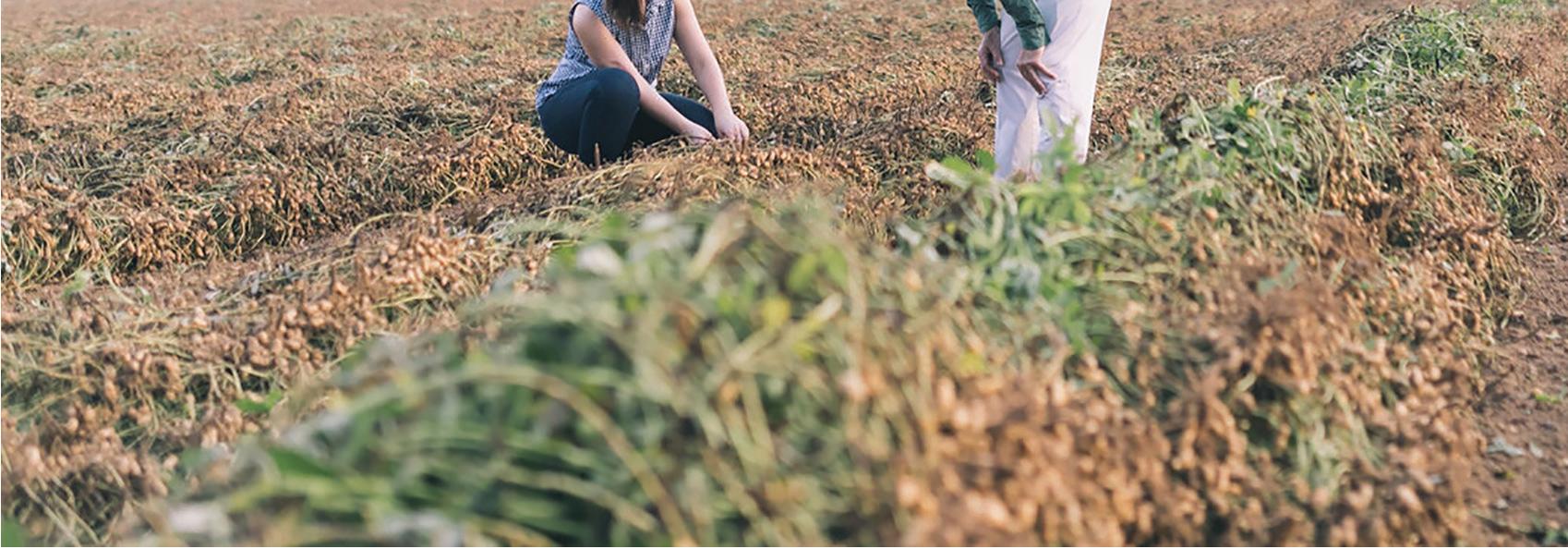



MAY 2024 • THE PEANUT GROWER
NATIONAL PEANUT BOARD
Jobs Act exemption, affect only about 4% of farms, but those farms represent over half of the productive acreage of the United States
The enhanced exemption is set to expire at the end of 2025. If levels went back to pre-exemption, he says, it would almost double the percentage of farms subject to the estate tax, and affected acreage would go up to almost three-quarters.
Still, Covington says, farmers are a resilient group of people. There is still vitality in the family farm; although he says he does see the family farm becoming a smaller portion of the agricultural space as time goes on.
Sherer says the younger generations’ understanding of technology presents many opportunities for diversifying farm operations and their revenue streams.
Covington says families looking to pass on their farms to younger relatives need to start preparing now, developing relationships with strategic partners like lawyers and accountants.
He says families must start setting up a succession plan –who will take over operations – and an estate plan – the division of assets. This starts with an important question for heirs: Do you want to be here, and if you do, how do you see your role?
“These conversations cannot be had around a breakfast room table or out in a pickup truck,” Covington says. “These discussions have to be had in a business environment. They often require a mediator.”
Building For The Next Generation
Kerr says her family’s transition has been a learning process. “I wanted to absorb as much information as possible from my dad, from our farm manager,” Kerr says. “Between the two of them, they have so much knowledge. It will take me years to even come close to understanding everything that they just know so easily.”
Kerr’s 69-year-old dad is still a very core part of the operation, she says. She takes videos to watch as he explains responsibilities like how to develop planting schedules and crop rotations.
Still, he’s taking a three-week vacation in the middle of Longleaf Ridge’s next harvest season. Kerr says it’s something he never would have dreamed of doing before.
“I think he realizes that we can handle this without him and he’s free to go enjoy himself and do things he wants to do,” she says. “I’m really glad he’s starting to feel that freedom.”
Kerr says she was nervous about how her community would react to her taking over the farm. Historically, it is rare for farm operations to be handed down to a daughter.
Women accounted for 36% of the country’s 3.4 million producers, according to the 2017 Census of Agriculture. She says she feared people wouldn’t take her seriously.
However, her experience has been the opposite of what she expected, and she says she’s received abundant support from the agricultural community.
“When it comes down to it, it doesn’t matter that I’m a woman,” Kerr says. “I am just someone’s child returning home to the farm who loves this land and loves this community, and they are so excited and so proud to see that.”
She says it’s great to see more young women empowered to take over their family farms as women, and young people in
“The younger generations’ understanding of technology presents many opportunities for diversifying farm operations and their revenue streams.”
DUSTIN SHERER, Farm Bureau director of government affairs
“There’s such a value in the combination of wisdom and knowledge that the past generations have acquired over a lifetime, combined with the energy and vision of the next generation.”
CASEY COX KERR
South Georgia farmer
general, bring a fresh perspective.
“There’s such a value in the combination of wisdom and knowledge that the past generations have acquired over a lifetime, combined with the energy and vision of the next generation,” Kerr says.
She says her family plays on each other’s strengths to build a stable foundation for the future of the farm.
Kerr and the Longleaf Ridge team are working to replant and reestablish some of the longleaf forest that was destroyed in Hurricane Michael. Longleaf wiregrass ecosystems are among the most biodiverse ecosystems in North America outside of the tropics.
They’re also implementing new technologies onto the farm, like remote, automated irrigation. Kerr says she is able to control irrigation systems as well as check soil moisture using realtime data in an app on her phone.
She says she and her husband also are in the early stages of developing a consumer-facing side of the business that is connected to the farm but also an independent, stable source of revenue. People may be buying her corn from the grocery store shelf, but they have no idea who is behind its production.
“I think there’s such a strong desire for consumers to connect with farmers and know where their food comes from,” she says. “So, we want to really create something that can be that conduit where there’s a face to the farm.”
Kerr gave birth to her first daughter last year – in the middle of harvest season. She says having a child has changed her whole perspective.
“I have a renewed sense of purpose to build this into something for her,” Kerr says.
When the time comes, she says she’ll give her daughter the gift of choice, but she plans to build on what her parents gave her and make it better for the next generation. PG
Article by Lucille Lannigan, a Report for America Corps Member, for The Albany Herald.
18 / THE PEANUT GROWER • MAY 2024 PEANUTGROWER.COM
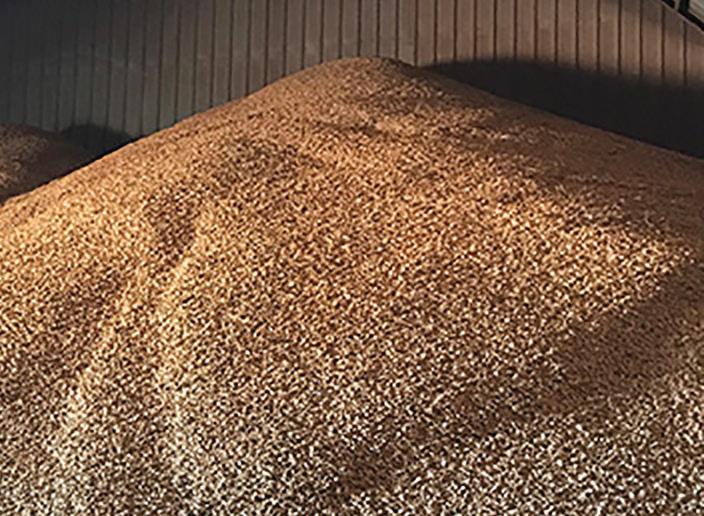




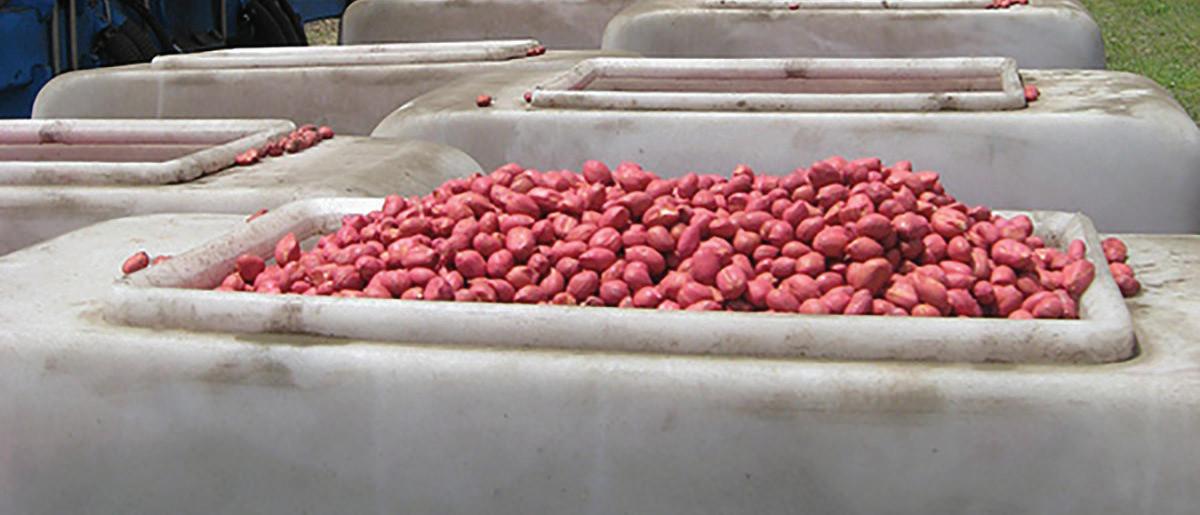























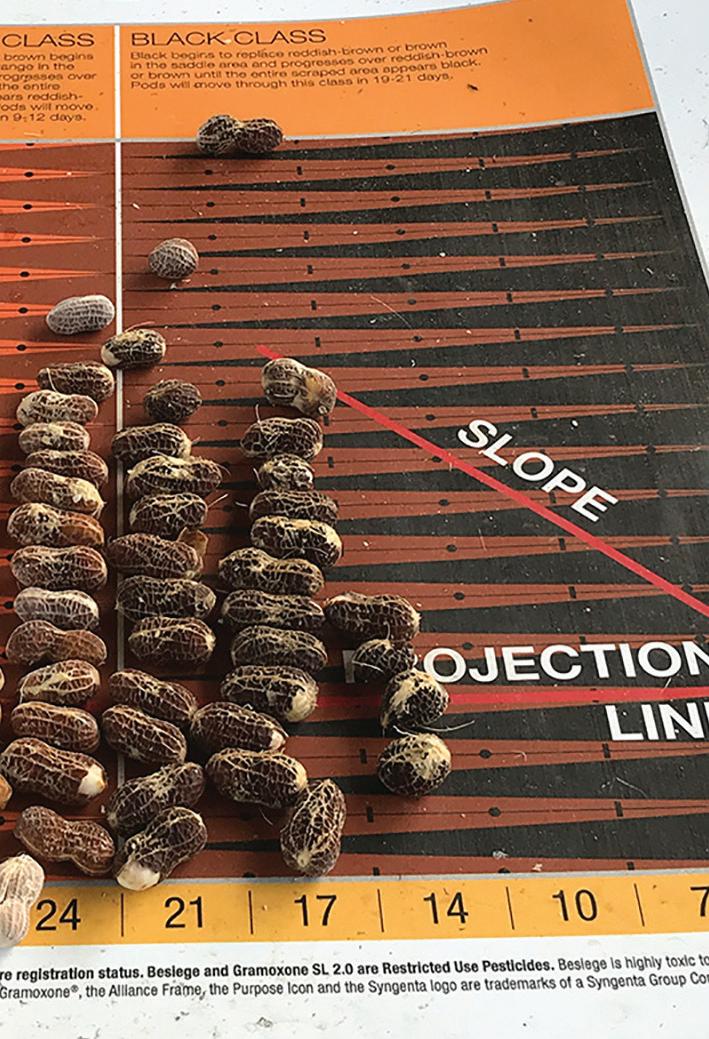

















We work hard at what we do because we know you work hard at what you do. Between our print and digital o erings, Peanut Grower is here for you year-round. www.peanutgrower.com@PeanutGrower PeanutGrower@ ePeanutGrower Don’t miss an issue! Scan the QR code with your phone to renew today for FREE!


Peanut Pointers
Know Your Seed’s Germination Percentage
 EMI KIMURA
Texas A&M AgriLife Extension
State Extension Peanut Specialist
EMI KIMURA
Texas A&M AgriLife Extension
State Extension Peanut Specialist
Planters are slowly starting to roll this week in West and Central Texas and the Rolling Plains. South Texas peanut planting will start in the next two to three weeks. By this time, producers know what market types and cultivars they will plant; however, there are a few things to consider when planting different market types in a field.
Spanish- and Valenciamarket types are better suited for fields with limited irrigation capacity due to their shorter-season characteristics. Runner- and Virginia-market types take longer to develop into maturity; therefore, they require more irrigation water. In addition, these market types stay in the soil longer, result-
ing in a higher probability of getting disease infestation. Planting the runner- and Virginia-market types into fields with a limited disease history can reduce the risk of getting disease by soilborne pathogens.
In a field with history of nematode infestation, it is a good idea to use nematode-resistant cultivars. NemaTAM II was released by the Texas A&M AgriLife Research peanut breeding program. It is a high-yielding, high-oleic, large-seeded, runner-type peanut cultivar with resistance to root-knot nematodes. In a statewide peanut variety trial, NemaTAM II ranked first in a location with nematode infestation.
Finally, it is always important to use high-quality seed and check for splits and immature kernels prior to planting. Adjust your planting population based on the percent germination. This information can be obtained on the bag of seeds or by calling the supplier. You can also obtain percent germination by placing 100 random seeds on a wet paper towel, preferably multiple sets of 100 seeds, rolling them up, and putting them in a zip lock bag for five to seven days. Unroll and count the number of germinated seeds to obtain the percent germination. If the total is 80%, divide your seeding rates by 0.8.
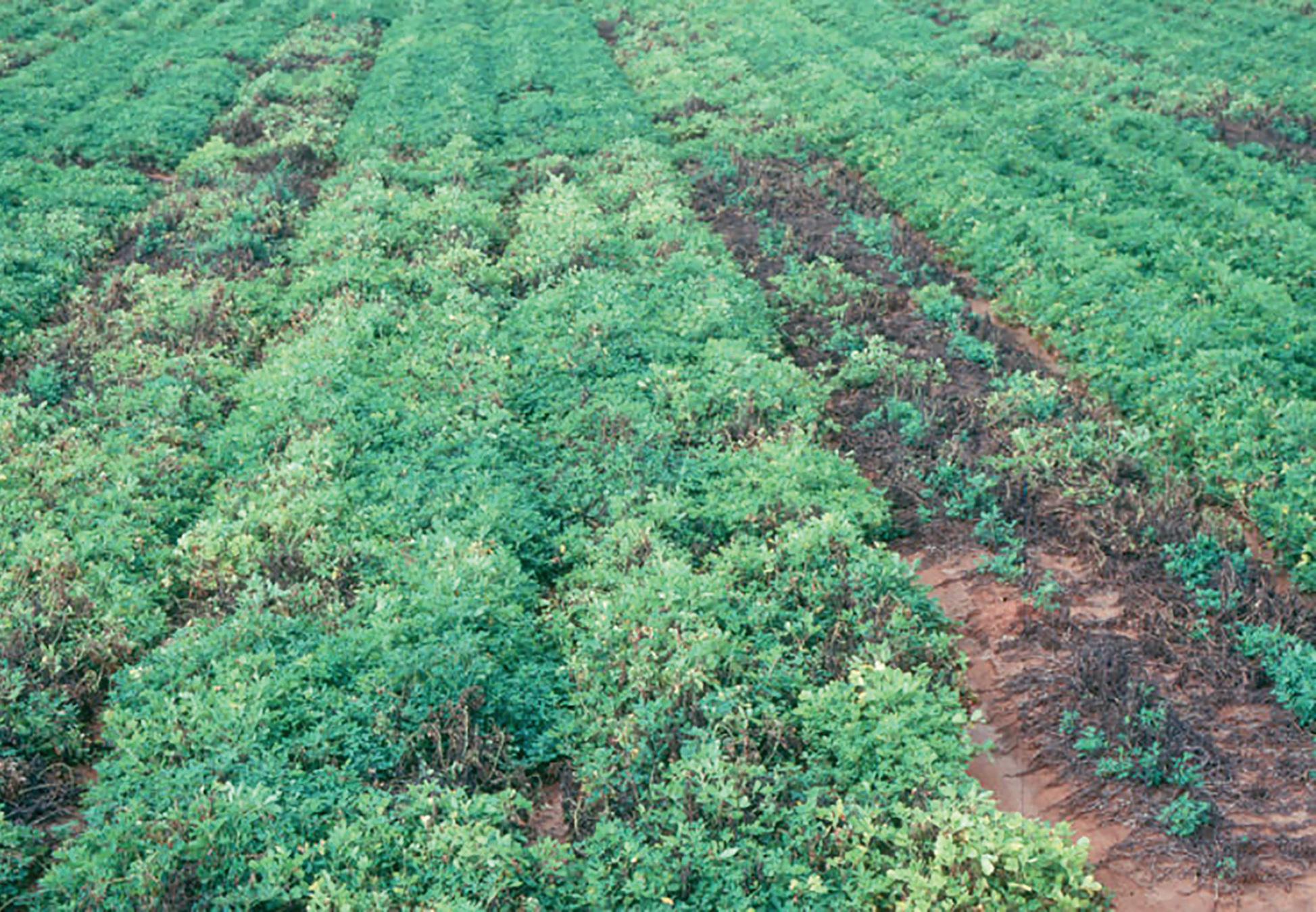
20 / THE PEANUT GROWER • MAY 2024 PEANUTGROWER.COM
Texas A&M peanut breeding plots


Peanut Pointers
Gypsum Availability The Topic Of Coffee-Shop Talk

I hope planting season goes relatively smoothly this year, but realistically, growers are likely to have a few weather-related issues before all the peanuts are planted and emerged. Follow the 10-day forecast closely to limit potential issues. This is critical for planting in early May. Cool, wet weather, along with seed quality problems, caused many acres to be replanted last year. Hopefully, seed quality will not be an issue, but given last year’s growing conditions, I am a little concerned about this year’s seed quality.
To help minimize seed issues, I encourage growers to take care of their seed like they would a newborn baby. Keep seed in stable environmental conditions until planted. Handle with care, and do not plant in subpar conditions.
The seeding rate in relation to cost per acre is another thing to consider. It costs an estimated $20 for every seed per foot/per acre that you put in the ground. For example, six seed per foot costs a grower roughly, depending on size, $120/acre. If you plant eight seeds per foot, it would be an additional $40/acre.
Gypsum availability has been a coffee-shop topic of late. It (gypsum) is the primary way to obtain calcium for your peanut crop. It is available; however, it will either take some effort to secure, or it could be a different gypsum type. For example, most growers typically use AgriCal (smokestack/ synthetic) or USG 500. AgriCal is the gypsum type that appears to be less available this year. PCS Phosphogypsum is also available, although it is not as widely used.
Lime products are another option for obtaining calcium needs as long as your fields need a pH adjustment. Timely lime applications occur before or at planting to allow lime to break down and calcium to become available.
For growers who are unable to secure the above-mentioned gypsum types, calcium chloride and calcium thiosulfate are some liquid calcium products you can apply at high volumes, 10 to 30 gallons/acre, through the pivot or on the ground and watered in. Although these products will provide calcium, they are not as effective as gypsum in suppling calcium needs for peanut. Polysulfate and calcium nitrate have also been tested, but at the current manufacturer’s recommended rates, they do not provide enough calcium for peanut.
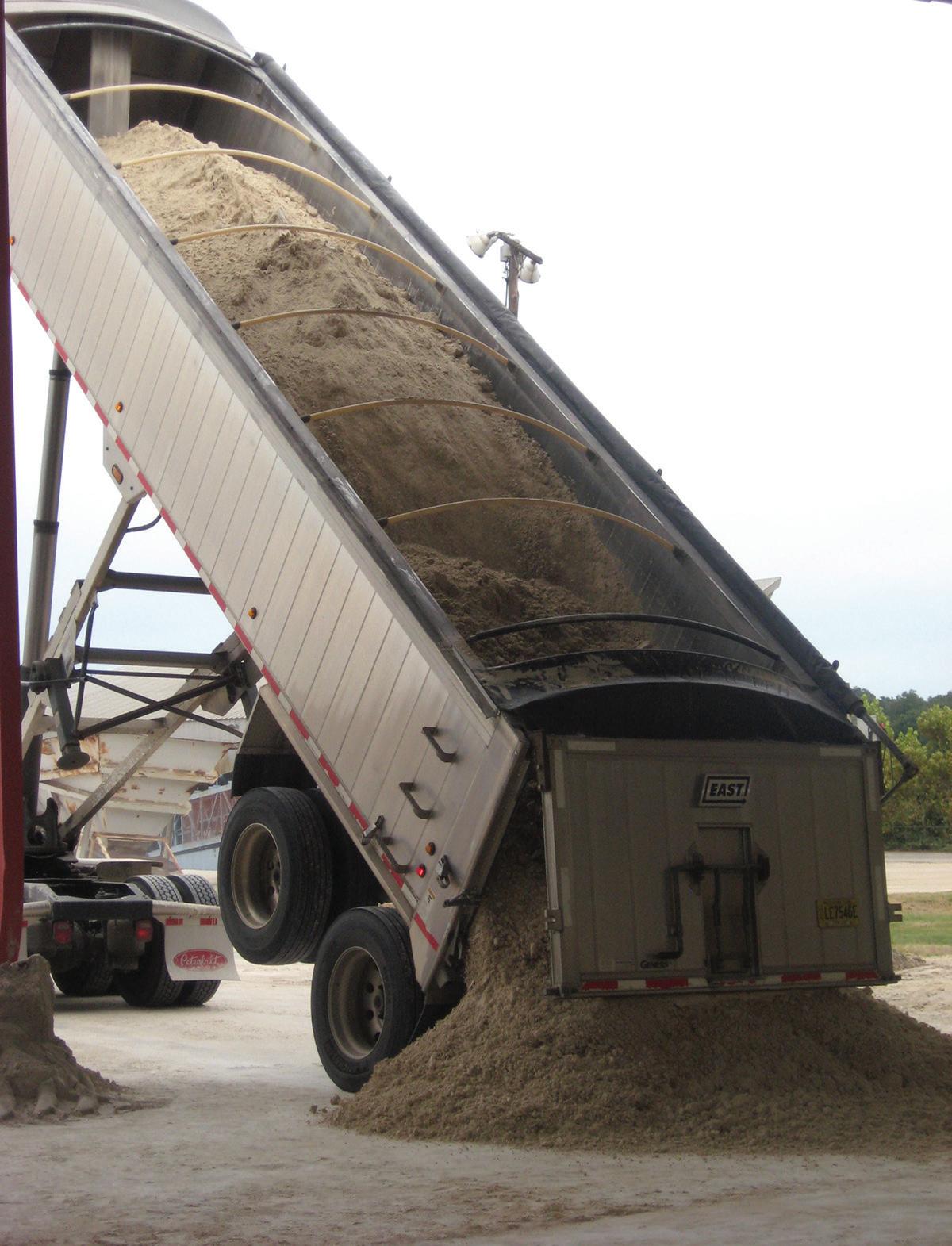
Lastly, growers need to know that foliar calcium products applied at low rates will not work and are not recommended. Like always, call your local county agricultural agent for help.
Be Sure To Kill, Not Just Cover, Weeds

When we get into May, we have already invested a lot in the peanut crop and set the stage for yield potential. Weed scientists talk a lot about the critical period of weed interference. For peanuts, that’s generally during the first six weeks of the season. To optimize yield, we need the crop to grow without competition from weeds during this time. Certainly, we need to dig peanuts, and weeds that come in later can interfere with that process and create major pod loss. However, controlling weeds during the first month or so after the crop emerges
MAY 2024 • THE PEANUT GROWER / 21 | @PEANUTGROWER
SCOTT MONFORT
University of Georgia Extension Agronomist
DAVID JORDAN
North Carolina State University Extension Agronomist


Peanut Pointers
really sets the stage for optimizing yield. That is why we encourage an effective burndown program for reduced tillage and adequate, uniform tillage in conventional tillage.
The money we spend upfront brings in a dividend. If you can incorporate a herbicide, that is a great start. If not, apply residual herbicides right after the planter, and add a contact or systemic burndown to the mix if there are emerged weeds. This happens sometimes when we till and get delays in planting. We get out of sync. Another challenge can be wet weather prior to tillage. Sometimes we are just covering up weeds and not killing them when we disk. The result can be that in a few weeks, you have 12-inch weeds scattered across the field. If there is any doubt about how well you can kill all the weeds with tillage, apply an effective burndown before you begin tilling. It may seem like a waste, but if you are just covering up some of the weeds with a disk, you will be chasing them in a few weeks.
After planting, and regardless of how good you think your weed control is, make sure you don’t have any small escapes. I often recommend paraquat plus Basagran plus residuals about three weeks after peanuts emerge. In the Southeast, Storm plus paraquat is used a great deal. Either combination serves the purpose of cleaning up the weeds that slipped through at-planting herbicides.
In the Virginia-Carolina region, it’s critical to stay on top of thrips. We are often a week or so late for our foliar sprays to suppress this insect pest. If peanuts are stunted and terminals are in poor shape, we are indeed late spraying, and we may have experienced yield loss and greater transmission of Tomato Spotted Wilt Virus. Be proactive on these sprays.
As we move through May, we might have some fields that have less-than-ideal stands. What does less-than-ideal mean? In a perfect world, you would have four to five plants per
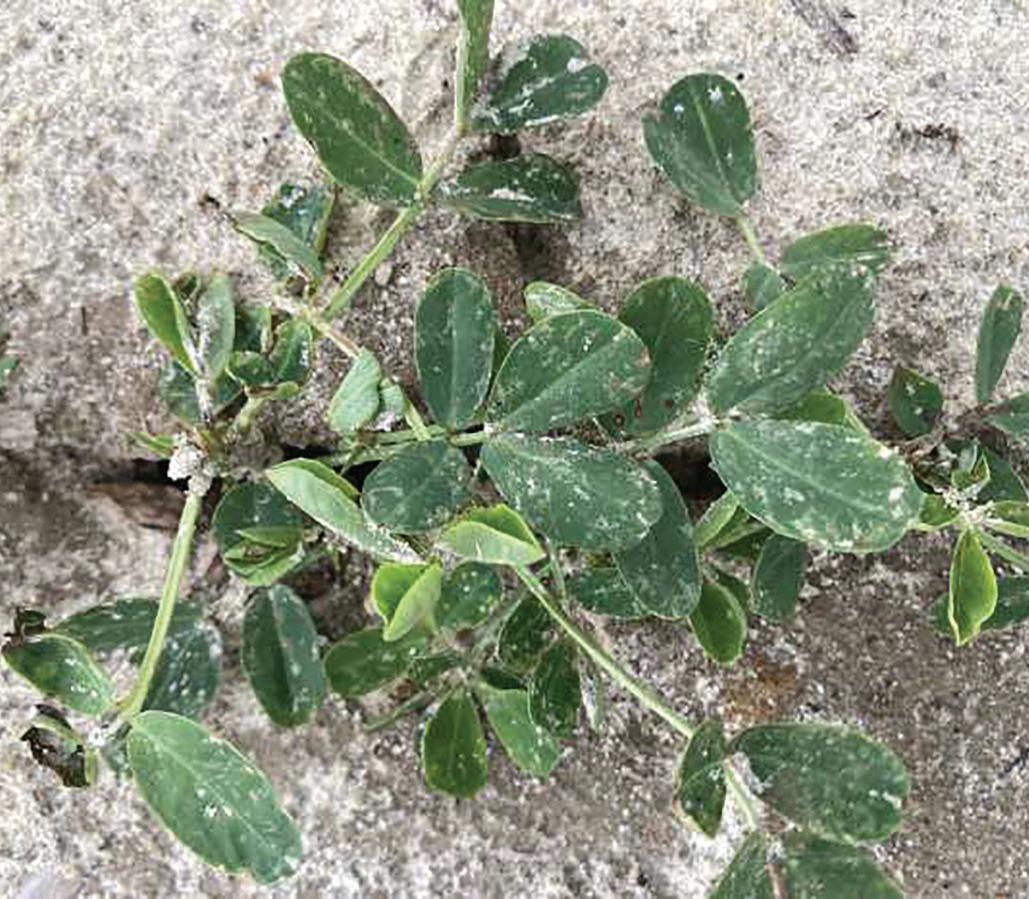
foot of row all the way across the field. What if you have three plants or perhaps two? I would say three is OK, but yield will be lower than four or five. But, I wouldn’t replant if I had at least three across the field. Less than two needs replanting, while between two and three can be a gray area. Peanuts can take a long time to make a stand, especially in the upper V-C, and that can make it challenging to know whether to jump in with a replant or plant a few more seed to the side of the initial planting. Large gaps in stands can be the major issue, and if you have many of those, a replant is needed. This type of situation most often warrants a phone call and discussion. In June, I’ll hit on fertility issues for Virginia-market types and some thoughts on fungicide programs.
Don’t Give Palmer Amaranth A Head Start

As you read this issue, I feel that we will be in full swing planting peanuts this year, which is different than the past two planting seasons. So far during the month of April, even though we have had some cool nights, our daytime temperatures have been relatively warm. Therefore, when you look at our soil temperatures, they also have been higher overall for April this year compared to the past two years. This makes me think about being more cautious in regard to seedling disease.
Aspergillus crown rot, in particular, is more prominent when we have hot and dry weather. Writing this ahead of time, I certainly don’t know what weather we will be experiencing at the time but hopefully it won’t be hot and dry. I just want us to be cautious and prepared. Some of us have had 25 inches of rain from the first of the year up until mid-April. Therefore, our best defense is to have the best seed treatment on the seed in addition to a fungicide in the furrow.
Also, I am still getting questions about the use of preemergent herbicides behind the planter damaging peanut stands. As I mentioned earlier, this year seems different than last year’s planting season. We experienced 10 to 15 inches of rain right after planting last year and it didn’t reduce our plant stands. This was mainly because of the high-quality seed and well-drained soils. Therefore, don’t hesitate and give palmer amaranth the chance to get a head start.
22 / THE PEANUT GROWER • MAY 2024 PEANUTGROWER.COM
Thrips injury on untreated peanuts.
KRIS BALKCOM
Auburn University Extension Specialist
NUTRI-MAX BLOOM MASTER™ Delivers a Peanut Yield Boost of 300 Pounds Per Acre


Peanut yield is dependent on maximizing nut set, which is linked to a large and prolonged bloom. A variety of macro and micronutrients influence the plant’s ability to achieve a strong nut set. Ensuring peak nutrient demands are met and sustained from just before and throughout the bloom period is key to top yielding peanut fields.
Bloom Master Satisfies Peanuts’ Huge Appetite for Nutrition
While every growing year has its unique challenges, Meherrin’s dedicated research team has proven over a three year period how to successfully influence yield by focusing on sound agronomic principles and providing the right nutrients, in the right forms at the right time.
This is where Nutri-Max Bloom Master, provided by Meherrin, offers a vital solution, providing essential nutrients to support peanut plants effectively. These nutrients serve some important roles in peanut plants.
• Nitrogen – Peanut plants need 250 pounds of nitrogen to produce the valuable nuts.
• Sulfur – This secondary nutrient is essential for the formation of protein synthesis, vitamins and enzymes, as well as photosynthesis and energy transfer for peanut size and quality.



Nutri-Max Bloom Master delivers a yield boost of 5% to 6%, which equates to 300 more pounds of peanuts per acre and a nice increase in profits.


• Manganese – This nutrient helps plants better utilize nitrogen, boosting plant growth, peanut yield and overall crop quality.


For Farmers Who Are Nuts About Peanuts, Nutri-Max Bloom Master Delivers.
Bloom into a more profitable peanut harvest with Nutri-Max Bloom Master.



Peanuts pack quite a punch in tiny packages. DISTRIBUTED BY:
For more information on how Meherrin can help your peanut yield contact your local Meherrin representative


agro-k.com
Meherrinag.com
Since 2001, the has invested more than �36 million National Peanut Board in food allergy research, outreach and education. Learn more at NationalPeanutBoard.org























































 J. Tyron Spearman Contributing Editor, e Peanut Grower
J. Tyron Spearman Contributing Editor, e Peanut Grower






















































 EMI KIMURA
Texas A&M AgriLife Extension
State Extension Peanut Specialist
EMI KIMURA
Texas A&M AgriLife Extension
State Extension Peanut Specialist





















